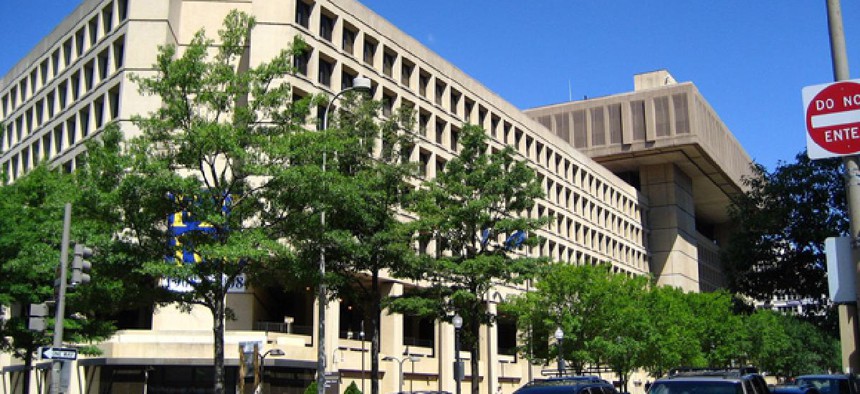Land-swap idea for FBI headquarters draws hundreds of interested parties
Cost-saving idea to move out of Hoover building is linked to GSA’s new mission.
An idea to trade the FBI headquarters building in downtown Washington for a larger and more modernized site is looking like a winner.
More than 300 contracting and real estate professionals packed the General Services Administration’s still-under-renovation headquarters on Thursday to learn details of the project.
Delays in getting the standing-room-only crowd through security “bode pretty well for this project, and the amount of interest continues to grow,” said GSA's acting Administrator Dan Tangherlini. He linked his team’s work on moving the FBI to the GSA’s revised mission statement unveiled on Monday: “to deliver the best value in real estate, acquisition, and technology services to government and the American people.”
The “Industry Day” event expanded on a request for information GSA published in December seeking expert suggestions for sites in the greater Washington area that current owners could consider exchanging for the FBI’s aging and cramped J. Edgar Hoover building on prestigious Pennsylvania Avenue Northwest.
Tangherlini called the 39-year-old Hoover building “an ineffective asset that is not fulfilling its potential.” With space for only 54 percent of FBI headquarters employees in the squat structure, law enforcement and intelligence professionals “can’t collaborate the way we need them to, so its time has come,” he said. Another GSA official joked that the building has been dubbed “the only undeveloped site on Pennsylvania Avenue.”
Pat Findlay, assistant FBI director for facilities and logistics services, said he admired Tangherlini’s energy, noting that the administrator, who took over GSA following a scandal over wasteful conference spending, met last year with FBI Director Robert Mueller for six hours on the move, which has been discussed for seven years. Findlay spoke of the building’s “obsolete, poor and wasteful design,” noting that a renovation of the 6.6-acre site would cost $850 million.
“Since 9/11, we’ve had a 100 percent increase in staff,” he said, noting space and security requirements for new missions in intelligence and cybercrime.
The new site, as authorized by the Senate Environment and Public Works Committee in December 2011, would require 2.1 million rentable square feet for 11,000 employees on a site totaling 40-50 acres. The new building would require the highest (level V) building security, meaning blast-proof, and would have to be near public transportation. “A very small portion of our employees drive cars,” Findlay said, citing the need for 4,300 parking places. The possibility of a public-private leasing partnership would save the government $44 billion-$54 billion annually, he said.
GSA is looking to complete an exchange, said Bill Dowd, GSA’s acting regional commissioner for the National Capital Region, in which “the developer would own the Hoover building, but the government would own the new site.” An added benefit for people “craving vitality in the city would be help with the revitalization of the Penn Quarter neighborhood,” the location of the Hoover building.
Members of Congress representing the Virginia and Maryland suburbs have made plays to host the FBI’s new location.
Matt Gaither, the GSA’s project manager, said the request for information, submissions, due March 4, “may lead to a request for proposal.” But this one is “very general, not restrictive,” he said. It should address how to accomplish the envisioned exchange, the timing, the finances, the valuation of the properties and the arrangements for transitioning the FBI employees while their work goes on.
Panning back to GSA’s big-picture agenda, Dorothy Robyn, now in her fourth month as commissioner of the Public Buildings Service, called the FBI project “our latest effort to do more with less.”
The agency faces three big challenges, she said. The average age of its aging portfolio of 350 million square feet is 47 years. “As Neil Young famously said, rust never sleeps,” she said.
GSA also faces limited capital for revinvestment, with its buildings fund unlikely to win hikes in rent charged to agencies. “Flat is the new up,” she was told by the Office of Management and Budget. Thirdly, GSA will rely more on leased space rather than space the government owns.
To address those challenges, Robyn said, GSA is “rightsizing its portfolio.” That includes redesigning workspace use to facilitate “an open, collaborative workforce” as well as disposing of unneeded federal assets. (On Friday, GSA opened a month-long online auction to sell off its Georgetown West Heating Plant in Northwest Washington.)
GSA will also continue advancing sustainability in buildings -- energy consumption in federal buildings dropped 6 percent in 2012, Robyn said. Finally, GSA hopes to leverage its historic buildings, she said, citing the ongoing planning with the Donald Trump company for long-term lease of the Old Post Office Building on Pennsylvania Avenue, which Trump will convert to a luxury hotel, but which eventually will revert back to the government.




